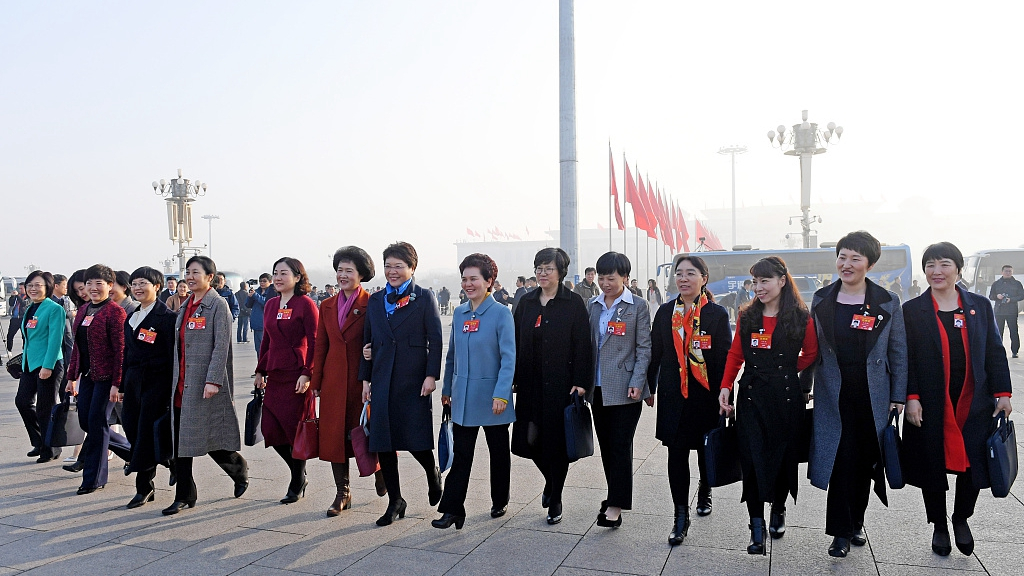
Domestic
18:14, 08-Mar-2019
China marks highest rate of women in national congress, improvement needed to promote engagement
Yang Di

China's 13th National People's Congress (NPC) has seen 742 women out of the total of 2,975 lawmakers, or 24.9 percent, registering the highest gender ratio ever in the legislature's history. Despite the increase, more effort is still needed to enhance women's representation in the national legislature.
China's 2019 "Two Sessions," the annual legislative event that consists of the People's National Congress and Chinese People's Political Consultative Conference, is currently held in Beijing.
The gender ratio in the national legislative body had never been so close to 1:4, which over the 25 years leading to the second millennium was steading at slightly higher than 1:5.
The ratio in China's legislature has also exceeded the world average of 24.3 percent, according to data crunched by Women in National Parliaments, a United Nations' program, as of January 2019. The average for Asia is 19.9 percent. With the increase, China has also closed its gap with the developed countries in Northern America and Europe.
Elected in 2018, the 13th NPC has marked the third consecutive expansion for the congresswomen group since the beginning of the 21st century. The rate was 23.4 percent for the 12th Congress, 21.33 percent for the 11th and 20.20 percent for the 10th (2003), with re-election being held every five years.
The rate of woman members in the 13th CPPCC, the country's top political advisory body, has also exceeded 20 percent, becoming the highest since the establishment of the People's Republic of China.

A lawmaker walks in the Great Hall of The People, March 5th, 2019, Beijing, China. /VCG Photo.
A lawmaker walks in the Great Hall of The People, March 5th, 2019, Beijing, China. /VCG Photo.
The increase of female lawmakers in the national Congress has been translated into more exposure to the important debates around women's welfare on the national legislative platform. During this year's "Two Sessions," one of the most heated discussions has been over China's struggle with maintaining a stable birth rate. Many NPC lawmakers and CPPCC members have proposed that China needs to create more encouraging environment for families that want to have children, including removing policy obstacles and introducing safeguards to woman employment during pregnancy.
"Children born out of wedlock ought to be able to register for a Hukou, too," proposed Huang Xihua, a lawmaker from southern China's Guangdong Province, referring to China's household registration system where children whose parents are not married cannot be registered.
Since 2001, a series of legislative development has been made concerning the protection of woman's rights with the increasingly stronger representation of women in the NPC.
China's anti-domestic violence law was passed through the NPC in 2015 and put into practice the next year, setting up the country's first legal infrastructure for curbing the misbehaviors. According to the China Anti Domestic Violence Network, an NGO, more than 60 percent of the cases reported to it by last November involved women being the victims.
The Law on the Protection of Rights and Interests of Woman, first introduced in 1992, was amended in 2005.
Despite the improved gender ratio in the NPC, there remains the margin for further enhancement in the national legislature. According to the data published by China's National Bureau of Statistics in February, women made up for 48.9 percent of the population of the Chinese mainland.
"To practice, politics requires knowledge not only acquired from textbooks, more importantly, through managerial experiences. Chinese women need more opportunities to accumulate the latter," said Zhao Jinfang, a former senior member of All-China Women's Federation.
In recent years a variety of researches have been conducted to gauge the impact of enhanced female political engagement across the world. The outcome is in general deemed positive.
One paper, jointly issued by the experts at the London School of Economics and Political Science (LSE) and Bocconi University in 2018, found reversed correlation between the number of woman lawmakers and the mortality rate of woman and children.
Using the World Bank's data collected from 1990 to 2014 for 155 countries, the authors had found evidence supporting the rule of ‘critical mass' of 30 percent: when the proportion of women in national legislatures reached 30 percent, the mortality rates for mothers and children fell faster.
(Top photo: Chinese woman lawmakers are seen at the Tiananmen Square, going to the Great Hall of The People, March 5th, 2019, Beijing. /VCG Photo.)

SITEMAP
Copyright © 2018 CGTN. Beijing ICP prepared NO.16065310-3
Copyright © 2018 CGTN. Beijing ICP prepared NO.16065310-3